

Paul Gorman /technical/network-osi.php. OSI (Open Systems Interconnection) is an ISO standard that includes a conceptual model that partitions aspects of networking into seven abstract layers.

Each layer has some overhead that can be thought of like a frame, which encloses data. That enclosed data includes the overhead of the next higher layer and that layer's data. And so on, like a Russian doll. Of course, this framing may not necessarily be what you might think of (packet headers and footers, for example) for all levels; the framing of a layer 1 protocol, for example, might simply be a specification defining voltages and signal timing. Remember: this is a conceptual model. Layer 1: the Physical layer A media layer. Layer 1 involves physical media (copper, fiber, radio, etc.), pinouts, voltages, repeaters, hubs, terminators, NIC's, media converters, connector specifications, etc. Understanding the Communication Layers. A network protocol is responsible for transporting data from the client computer to the database server computer.

This section describes the protocols used by the Oracle Protocol Support layer of the Oracle Net communication stack. It contains the following topics: OSI Reference Model Layer Summary. I know everyone hates ads.
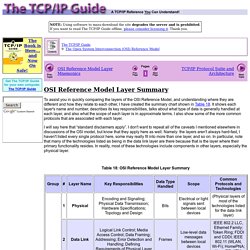
But please understand that I am providing premium content for free that takes hundreds of hours of time to research and write. I don't want to go to a pay-only model like some sites, but when more and more people block ads, I end up working for free. And I have a family to support, just like you. :) If you like The TCP/IP Guide, please consider the download version. It's priced very economically and you can read all of it in a convenient format without ads. If you want to use this site for free, I'd be grateful if you could add the site to the whitelist for Adblock.
Thanks for your understanding! Sincerely, Charles Kozierok Author and Publisher, The TCP/IP Guide. Packet Layer Protocol. Packet Layer Protocol or PLP is the Network Layer protocol for the X.25 protocol suite.
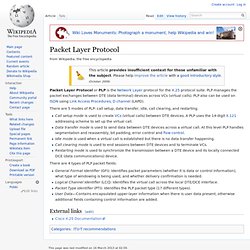
PLP manages the packet exchanges between DTE (data terminal) devices across VCs (virtual calls). PLP also can be used on ISDN using Link Access Procedures, D channel (LAPD). There are 5 modes of PLP: call setup, data transfer, idle, call clearing, and restarting. There are 4 types of PLP packet fields: General Format Identifier (GFI): Identifies packet parameters (whether it is data or control information), what type of windowing is being used, and whether delivery confirmation is needed.Logical Channel Identifier (LCI]): Identifies the virtual call across the local DTE/DCE interface.Packet Type Identifier (PTI): Identifies the PLP packet type (17 different types).User Data—Contains encapsulated upper-layer information when there is user data present, otherwise additional fields containing control information are added.Cisco X.25 Documentation.
X.25. X.25 network diagram.
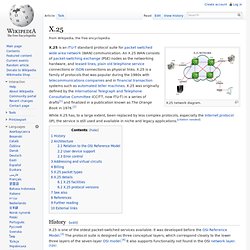
X.25 is an ITU-T standard protocol suite for packet switched wide area network (WAN) communication. An X.25 WAN consists of packet-switching exchange (PSE) nodes as the networking hardware, and leased lines, plain old telephone service connections or ISDN connections as physical links. X.25 is a family of protocols that was popular during the 1980s with telecommunications companies and in financial transaction systems such as automated teller machines. X.25 was originally defined by the International Telegraph and Telephone Consultative Committee (CCITT, now ITU-T) in a series of drafts[1] and finalized in a publication known as The Orange Book in 1976.[2]
AppleTalk. AppleTalk is a proprietary suite of networking protocols developed by Apple Inc. for their Macintosh computers.
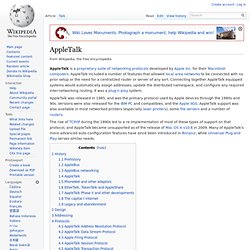
AppleTalk included a number of features that allowed local area networks to be connected with no prior setup or the need for a centralized router or server of any sort. Connecting together AppleTalk equipped systems would automatically assign addresses, update the distributed namespace, and configure any required inter-networking routing. It was a plug-n-play system. History[edit] Prehistory[edit] After the release of the Apple Lisa computer in January 1983, Apple invested considerable effort in the development of a local area networking (LAN) system for the machines. At that time, early LAN systems were just coming to market, including Ethernet, Token Ring and ARCNET.
Four months later, in October, AppleNet was cancelled. AppleBus[edit] Through this period, Apple was deep in development of the Macintosh computer. Internetwork Packet Exchange. The IPX/SPX protocol suite was very popular through the late 1980s into the mid-1990s because it was used by the Novell NetWare network operating system.
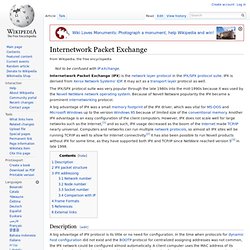
Because of Novell Netware popularity the IPX became a prominent internetworking protocol. A big advantage of IPX was a small memory footprint of the IPX driver, which was vital for MS-DOS and Microsoft Windows up to the version Windows 95 because of limited size of the conventional memory. Another IPX advantage is an easy configuration of the client computers. However, IPX does not scale well for large networks such as the Internet,[1] and as such, IPX usage decreased as the boom of the Internet made TCP/IP nearly universal. Description[edit] A small IPX network administrator had to care only.
IPsec (3. Network Layer) Internet Control Message Protocol. ICMP for Internet Protocol version 4 (IPv4) is also known as ICMPv4.
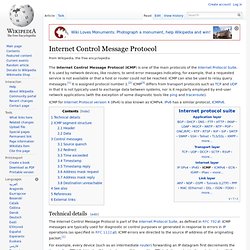
IPv6 has a similar protocol, ICMPv6. Technical details[edit] The Internet Control Message Protocol is part of the Internet Protocol Suite, as defined in RFC 792. ICMP messages are typically used for diagnostic or control purposes or generated in response to errors in IP operations (as specified in RFC 1122). ICMP errors are directed to the source IP address of the originating packet.[1] Although ICMP messages are contained within standard IP packets, ICMP messages are usually processed as a special case, distinguished from normal IP processing, rather than processed as a normal sub-protocol of IP. ICMP segment structure[edit] [edit] The ICMP header starts after the IPv4 header and is identified by IP protocol number '1'. Type.
OSI model (Networking Layers)